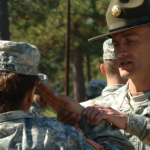Your Neighborhood Emergency Group – Planning Calendar Part 2

Grab my hand!
When you’re in real trouble, you’ll be so thankful to see that hand! You may be well prepared, but sometimes you just can’t do everything yourself. Sometimes you have to count on others. That’s where the neighborhood emergency group comes in.
Last week’s Planning Calendar introduced over a dozen ideas for improving emergency preparedness. I chose every one of these ideas because each could help you and at the same time could help build a neighborhood emergency group.
What makes up a neighborhood group?
I’ll start by describing what I think it is NOT. A neighborhood group is not people who have taken a formal training. It isn’t a church group or a scout troop. Why? Because these motivated people almost always come from across a wide local area. When their meeting or training is over, they scatter to head home.
For our purposes, a neighborhood is made up of the people who live next door and across the street.
Your neighborhood may extend to several blocks or up or down several floors in a large apartment building. It may be made up of 10 homes, or twice that many. We focus on this limited number of people for very specific reasons.
- Close neighbors tend to know who lives nearby – they know the size of your family, recognize your kids, your pets and your cars.
- Neighbors also tend to know family patterns. Who leaves for work when, who’s at home at a given time.
- Neighbors are the people who are nearby and can reach out a hand to save you when the disaster hits!
Neighbors make the difference when it comes to quick response.
When the tsunami and mud flows hit in Japan in 2011, people were dug out alive by neighbors who knew they were at home and even in what room they were likely to be! Of course, it doesn’t always work that way. In 2021, flood waters from Hurricane Ida filled up basement apartments in New York so quickly that not all residents were able to escape, despite the heroic efforts of neighbors.
Still, the advantages of being a part of a neighborhood group extend way past being able to save or be saved.
Over the years, we’ve surveyed our neighbors about why they participate in our neighborhood group. They give a number of reasons, of course. But the most frequent reason? “I want to be of service.”
We try to respect that and build on it as we plan our activities each year.
What makes a good neighborhood emergency group activity?
Whether it’s held in a community room, a living room or a back yard, a good meeting has at least these three components:
- Valuable information (preferably information that the group members have already indicated an interest in)
- A chance to practice or put new information or new skills to work
- Interaction giving group members a chance to get to know each other better
Of course, there are many more details for a meeting planner to consider – agenda, publicity, seating arrangements, etc. Here’s our own Meeting Planner Checklist if you’re looking for a good reminder. The main thing for planning: What’s your goal for this meeting?
What makes a good neighborhood emergency group?
Now, just because someone lives next door doesn’t mean they will be a good member of your neighborhood group. What are you looking for as you reach out with invitations? Your neighborhood team will be most successful when . . .
- Members share a common goal – in this case, “We want our neighborhood to be better prepared for emergencies.” (This broad goal includes the whole neighborhood. It doesn’t limit readiness to “the neighbors who have lived here for years” or “the neighbors that look like me” or “the neighbors that speak my native language.”) When an emergency hits the neighborhood, we’re all in it together!
- Members are prepared to take an active role. They come with ideas. (When people arrive saying, “I just want to see what’s going on . . .” it doesn’t bode well.) Of course, not everyone can do everything. But we have found that committed group members can always find a job they can do successfully.
- Communication is open. People are encouraged and expected to join in. Differences of opinion may arise, which leads to #4 . . .
- Patience is required. Not everyone comes with the same level of experience or understanding. (In fact, we have to go over basic building block info again and again.)
- Flexibility is essential. Every neighborhood is unique, so every group will be different. Moreover, over time, neighborhoods change. One “plan” may work for a while, but only until a better “plan” emerges.
Who makes the best neighborhood emergency group leader?
This is tricky. Often, someone with strong background in emergency training just naturally takes on the role of leader. For example, we have worked with groups where ex-military or trained First Responders are leaders.
However, they are not always successful!
Why not? There is a big difference between an official team – such as a military unit or a trained non-profit team – and a neighborhood group. Official teams know who’s in charge. They have had the same training. They expect to follow procedures and orders.
Neighbors are not necessarily ready to “follow orders” as laid down by someone down the block!
In a volunteer neighborhood organization, leaders have to earn their authority. What we have found is that the leadership roles often change, depending on the skills required at the time.
In our neighborhood group, for example, over the years we’ve had medical professionals step up and do intensive trainings for small groups of neighbors. Members with engineering backgrounds have headed up programs on detecting gas leaks. Just this last year a member with an interest in people with hearing and/or mobility loss managed a program that delivered an emergency whistle to everyone in her “division”!
Don’t overlook the value of CERT – Community Emergency Response Team training.
One source of reliable leaders to count on: your city’s CERT program. Every time we can welcome a new CERT graduate our neighborhood group is rejuvenated. CERT volunteers add vital strength to the team:
- Commitment to preparedness. (After all, CERT trainees self-select. They already have a preparedness mindset!)
- Grasp of response fundamentals: search & rescue, first aid, etc.
- Common language to describe emergencies, communicate with authorities, request assistance, etc.
- Familiarity with official response process – from First Responders, city government, Federal government, etc.
- Ongoing training opportunities (that they can bring back to the neighborhood group)
Even though they may be few in number, CERT volunteers are our best source of local neighborhood support and leadership. You can probably see why I dedicated our first books, the “Neighborhood Disaster Survival Guide” series, to CERT!

The Survival Guide series goes into much greater detail about developing leaders and how they effectively build a more engaged neighborhood. In each neighborhood the emphasis is on the benefits of working together.
Take another look at the Guide for your neighborhood if you haven’t seen it yet!
What’s a realistic goal when it comes to building a neighborhood group?
If your first goal is “helping our neighborhood be better prepared for emergencies,” you can meet it no matter the size of your group!
At the very least you can get valuable information to all your neighbors. Put articles in with the rent notice. Add tips to a neighborhood social media site. Publish a newsletter or flyers. If you’ve been reading our Advisories for a while you’ve heard how we have distributed a bottle of water to each of our neighbors along with a list of recommended emergency supplies; passed out friendly “Be my neighbor!” forms so people would exchange keys for use in an emergency; and distributed earthquake safety info in English and Chinese.
These educational activities have reached all our neighbors.
At the same time, we have invited interested neighbors to become active members of our neighborhood group. Our active group wants to learn more about the neighborhood (security vulnerabilities; gas line shut-offs, etc.) and develop new skills (how to operate walkie-talkies, a fire extinguisher, an emergency generator). They get particular satisfaction from serving other members of the community!
The active group varies in size, as you can imagine. In our community we’ve had as many as 90 active members (!). Today, after 2 years of Covid shut-down, we have only 37. Not enough for a neighborhood-wide “organization.” But we plan activities to reach out to everyone while we continue to work on ways to attract new “actives.”
When can you say you’ve been successful?
Helping create a resilient neighborhood isn’t easy. It doesn’t happen overnight, or even over the course of weeks. In fact, it’s an ongoing process since, just as neighborhoods change, so do the emergencies we are likely to face!
What doesn’t change, though, is the satisfaction of getting to know and to trust more of your neighbors. General Dwight Eisenhower – born in Texas, raised in Kansas, WWII General and 34th U.S. President — put it like this:
“The only things worth counting on are the people you can count on.”
I hope you’ll find something in this long discussion that will strengthen your group and your own enthusiasm, too. And since this is all meant to help everyone, please share your own best ideas for building a neighborhood group!
Virginia
Your Emergency Plan Guide team


